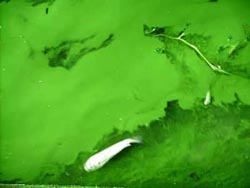
On last June 30, a group of aquatic botanists held a meeting in Beijing to review a research project on lake eutrophication and outbreak mechanism of blue-green algae, which has been completed recently. Coordinated by the CAS Institute for Hydrobiology (IHB) and the Chinese Academy of Environmental Sciences, the project has been supported by the "973" Program,a national key scheme for basic research..
At the meeting, Prof. Prof. LIU Yongding, first chief scientist of the project from IHB, and his co-worker reported the achievements of the five-year research.
First, targeted at shallow freshwater bodies in the Yangtze valley, the project made a systematic exploration into the formative reasons of lake eutrophication, its resultant ecosystem changes, and its countermeasures. The exploration was carried out from four aspects, namely, biogenic elements, aquatic vegetation, blue-green algae and management of the lacustrine ecosystem. Researchers have developed theoretical principles and related methodology for modeling the eco-management and health diagnosis. Via the approach of the ecosystem's stable conversion in a certain scope, they have found out new routes for preventing the curse and provided scientific grounds for protection of the freshwater lakes in China.
Second, the researchers made an analysis on geo-biological-chemical circulation of biogenic elements at the water-sediment interface, and revealed the correlation between its imbalance with the blue- green algae outbreak. Their research results also include: the discovery of the four stages in the outbreaks, the dominant factors and threshold values in the process of the outbreak; the understanding of the generation and evolution of the algal toxicants as a result of the outbreak; the establishment of a parametric system at different stable stages in a shallow lake's ecosystem in the middle and lower reaches of the Yangtze; and the definition & explanation of the threshold values for the key nutritional loads & key driving mechanism at a stable stage of the ecological conversion.
Third, the project makes an interpretation of the aquatic vegetation's degeneration in a shallow freshwater lake located in the middle and lower reaches of the Yangtze, making clear the harm on submersed plants caused by the ammonia in a water body, establishing a formative model to depict the suppressive mechanism underlying the ammonia threat and determining some threshold values of the factors responsible for the degeneration. Furthermore, the scientists made suggestions on principles for remedying the depleted ecosystem and some parameters for the ecological rehabilitation.





